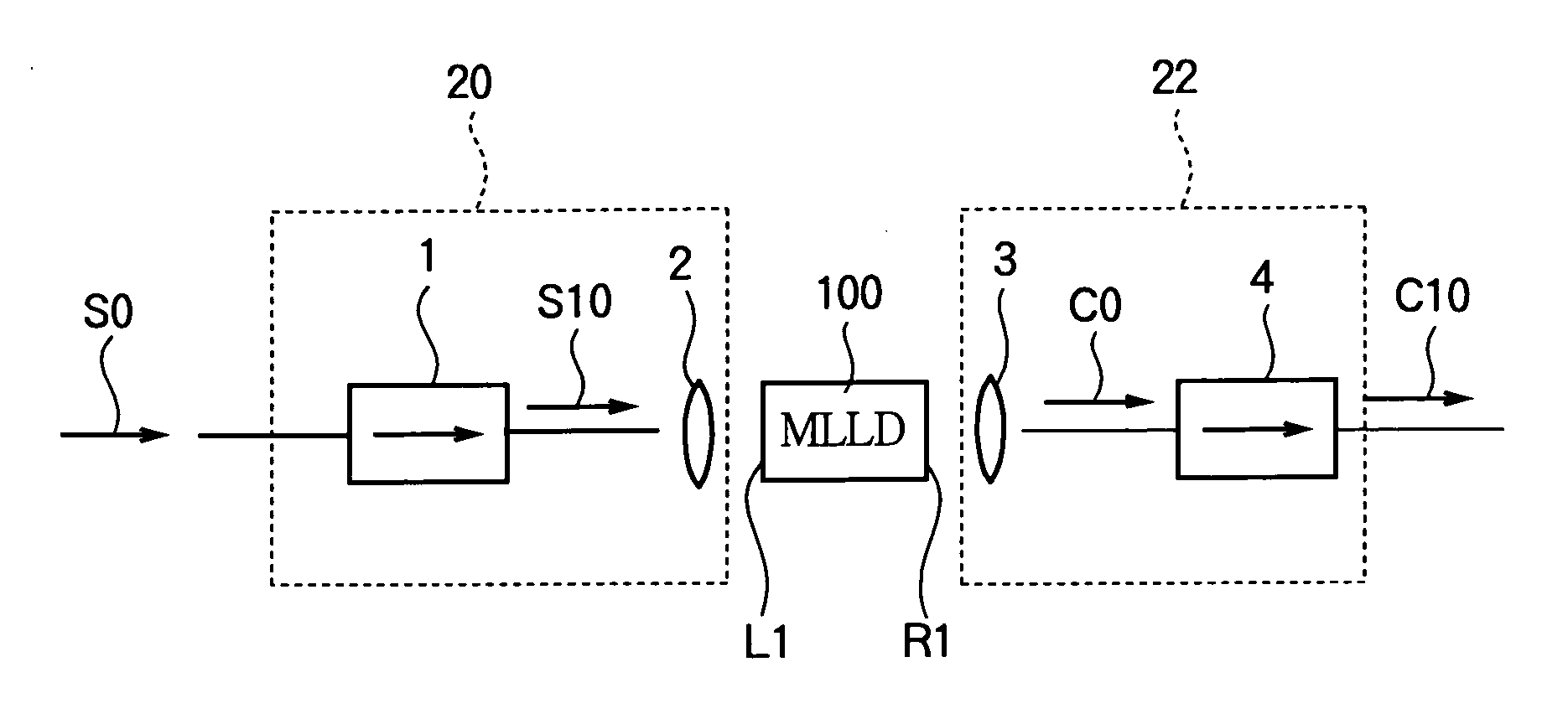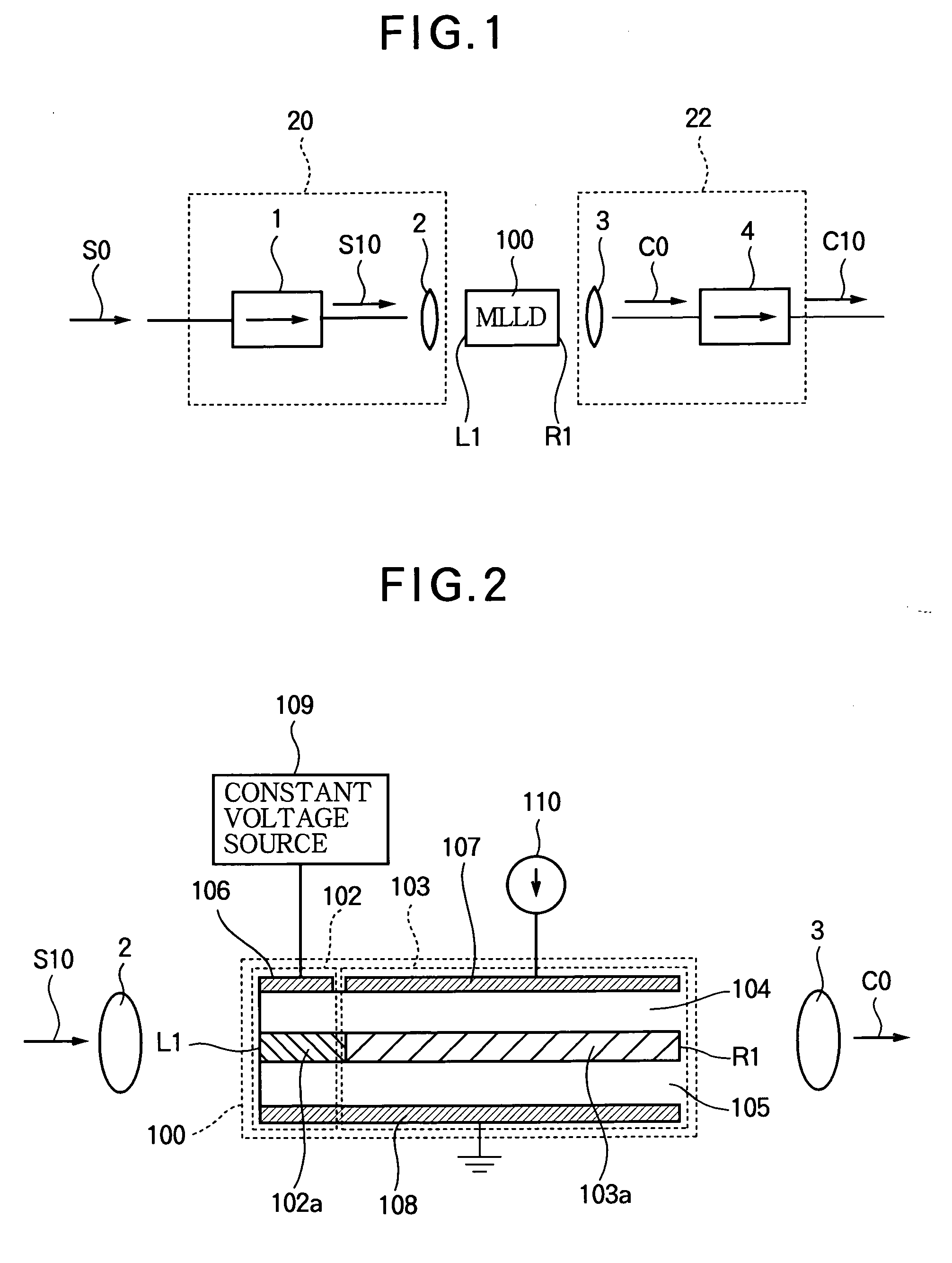Optical clock recovery apparatus and method and birefringent medium
a recovery apparatus and optical clock technology, applied in the field of optical clock recovery apparatus and method, can solve the problems of optical loss, optical signal degradation, waveform degradation in both the temporal and frequency domain,
- Summary
- Abstract
- Description
- Claims
- Application Information
AI Technical Summary
Benefits of technology
Problems solved by technology
Method used
Image
Examples
first embodiment
[0083]Referring to FIG. 1, the first embodiment is an optical clock signal recovery apparatus comprising a first polarization-dependent optical isolator 1 and a coupling lens 2 forming an optical input section 20, a coupling lens 3 and a second polarization-dependent optical isolator 4 forming an optical output section 22, and a mode-locked semiconductor laser, referred to below as a mode-locked laser diode (MLLD) 100, disposed between the optical input section 20 and the optical output section 22.
[0084]In the optical input section 20, the first polarization-dependent optical isolator 1 passes an input optical signal S0 received from an optical channel (not shown) through the coupling lens 2 to the mode-locked laser diode 100, and prevents light output from the mode-locked laser diode 100 from returning on the same optical channel. In the optical output section 22, the second polarization-dependent optical isolator 4 outputs the light generated by lasing in the mode-locked laser dio...
second embodiment
[0109]Referring to FIG. 4, in the second embodiment the input section and output section of the first embodiment are replaced by a single optical input-output section 24 disposed adjacent the left facet L1 of the mode-locked laser diode 100. The optical input-output section 24 comprises a polarization-dependent optical circulator 5, a Faraday rotator 6, and a coupling lens 8.
[0110]The polarization-dependent optical circulator 5 has an input port 5-a, an input-output port 5-b, and an output port 5-c. Light entering input port 5-a and polarized in a particular plane is output from input-output port 5-b. Light entering input port 5-a but polarized perpendicular to that plane is blocked. Similarly, light entering input-output port 5-b and polarized in the same particular plane is output from output port 5-c, while light entering input-output port 5-b but polarized perpendicular to that plane is blocked. A polarization-dependent optical circulator of this type can be constructed from pol...
third embodiment
[0115]Referring to FIG. 5, the third embodiment replaces the optical input-output section of the second embodiment with an optical input-output section 26 comprising a pair of polarization-dependent optical isolators 1, 4, a polarization-dependent optical coupler 7, and a coupling lens 9. The polarization-dependent optical isolators 1, 4 are similar to the polarization-dependent optical isolators in the first embodiment, the input optical signal S0 being input to the first polarization-dependent optical isolator 1 and the recovered optical clock signal C30 being output from the second polarization-dependent optical isolator 4.
[0116]The polarization-dependent optical coupler 7 has four ports 7-a, 7-b, 7-c, 7-d. Light input at port 7-a is coupled in equal or unequal portions to ports 7-b and 7-c. Light input at port 7-c is coupled in equal or unequal portions to ports 7-a and 7-d. The intensity ratio of the light output from port 7-b to the light output from port 7-c and the intensity...
PUM
 Login to View More
Login to View More Abstract
Description
Claims
Application Information
 Login to View More
Login to View More - R&D
- Intellectual Property
- Life Sciences
- Materials
- Tech Scout
- Unparalleled Data Quality
- Higher Quality Content
- 60% Fewer Hallucinations
Browse by: Latest US Patents, China's latest patents, Technical Efficacy Thesaurus, Application Domain, Technology Topic, Popular Technical Reports.
© 2025 PatSnap. All rights reserved.Legal|Privacy policy|Modern Slavery Act Transparency Statement|Sitemap|About US| Contact US: help@patsnap.com



